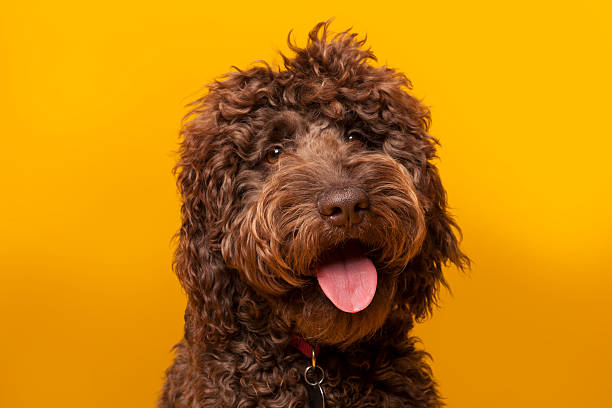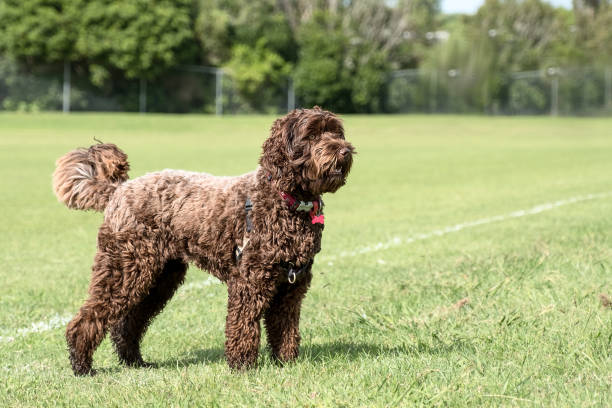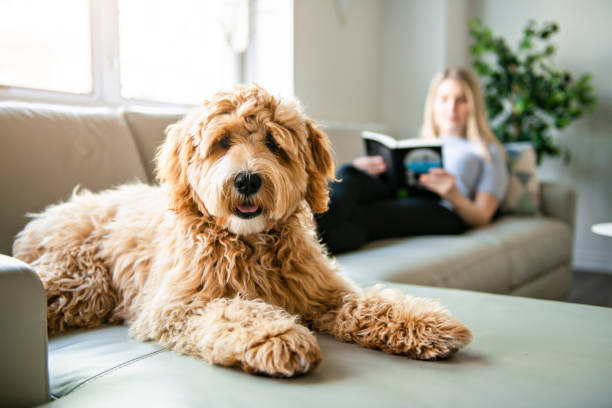Labradoodle

Breed History:
The Labradoodle is a designer hybrid created by crossing the Labrador Retriever with the Poodle, initially bred in Australia during the late 1980s. The primary goal was to produce a hypoallergenic guide dog combining the Labrador’s gentle temperament and retrieving skills with the Poodle’s intelligence and low-shedding coat. Labradoodles quickly became popular worldwide as friendly, intelligent family pets and therapy dogs.
Though not officially recognised by major kennel clubs as a distinct breed, Labradoodles have gained recognition through various clubs and organisations that promote responsible breeding and health standards. Their friendly nature, combined with adaptability and low-shedding qualities, makes them sought-after companions.
|
Gender |
Height |
Weight |
|
Male |
56–61 cm |
29–36 kg |
|
Female |
53–58 cm |
23–32 kg |
Size – Medium to Large
Life Expectancy: 12–14 years

Breed Appearance:
Labradoodles vary widely in appearance due to their hybrid nature, but they typically have a wavy to curly coat that can range from soft to woolly in texture. Their coats are often low-shedding, making them more suitable for allergy sufferers. Common colours include cream, chocolate, black, apricot, and parti-colour combinations.
They possess an athletic, well-proportioned build with expressive, almond-shaped eyes and a friendly, intelligent expression. Their ears are medium-sized and hang close to the head. Labradoodles have strong legs and a slightly tapered tail, reflecting their active and agile nature.
Breed Type – Family/Companion:
Labradoodles are renowned for their affectionate and sociable temperament. They are loyal, intelligent, and highly trainable, excelling in family settings, therapy work, and as service dogs. They bond closely with their owners and generally get along well with children and other pets.
While friendly with strangers, Labradoodles retain a protective streak that makes them attentive watchdogs. Their adaptable nature allows them to thrive in a variety of living conditions, though they prefer active households where they can participate in family activities.

Training:
Highly intelligent and eager to please, Labradoodles respond well to positive reinforcement training techniques. Early socialisation and consistent training are important to channel their energy constructively and prevent boredom-related behaviours.
They enjoy activities like obedience, agility, and scent work. Due to their intelligence, they can sometimes become mischievous without sufficient mental stimulation, so engaging training and games are recommended to keep them balanced and happy.
Health & Care:
Labradoodles are generally healthy dogs, but can be predisposed to health issues common in their parent breeds. These include hip and elbow dysplasia, progressive retinal atrophy (PRA), Addison’s disease, and allergies.
Regular veterinary check-ups, a balanced diet, and appropriate exercise are vital to maintaining their health. Their coat requires regular grooming to prevent mats and tangles, especially for dogs with curlier fur.

Living Conditions:
Labradoodles adapt well to both homes with large yards and apartment living, provided they receive ample exercise and mental stimulation. They thrive in families that can dedicate time to daily walks, playtime, and training sessions.
They do not do well when left alone for long periods and may develop separation anxiety if neglected. A secure yard or frequent outings are important to satisfy their active nature.
Exercise:
Moderate to high exercise needs require at least 60 minutes of physical activity daily. This can include walking, running, fetching, swimming, or interactive games. Labradoodles also enjoy mentally challenging activities like puzzle toys and obedience exercises.
Regular exercise helps maintain their physical health and supports their lively, playful temperament.
Grooming:
Labradoodles need consistent grooming, with brushing recommended several times a week to prevent mats and tangles, particularly in dogs with curlier coats. Professional grooming every 6–8 weeks is common for maintenance.
Bathing should be done as needed with gentle dog shampoo. Regular ear cleaning, dental care, and nail trimming are essential to overall health and comfort.

Advantages:
-
Friendly, affectionate, and intelligent
-
Low to moderate shedding, allergy-friendly for many
-
Highly trainable and adaptable to various roles
-
Good with children and other pets
-
Energetic but manageable with sufficient exercise
-
Suitable for families, therapy work, and service roles
Disadvantages:
-
Grooming needs can be demanding, especially with curly coats
-
High energy requires regular exercise and mental stimulation
-
Potential for separation anxiety if left alone too long
-
Some variability in coat type and temperament due to the hybrid nature
-
Can be prone to inherited health issues from the parent breeds

